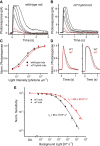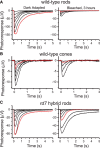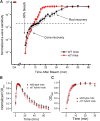Chromophore supply rate-limits mammalian photoreceptor dark adaptation
- PMID: 25143602
- PMCID: PMC4138333
- DOI: 10.1523/JNEUROSCI.1245-14.2014
Chromophore supply rate-limits mammalian photoreceptor dark adaptation
Abstract
Efficient regeneration of visual pigment following its destruction by light is critical for the function of mammalian photoreceptors. Here, we show that misexpression of a subset of cone genes in the rd7 mouse hybrid rods enables them to access the normally cone-specific retina visual cycle. The rapid supply of chromophore by the retina visual cycle dramatically accelerated the mouse rod dark adaptation. At the same time, the competition between rods and cones for retina-derived chromophore slowed cone dark adaptation, indicating that the cone specificity of the retina visual cycle is key for rapid cone dark adaptation. Our findings demonstrate that mammalian photoreceptor dark adaptation is dominated by the supply of chromophore. Misexpression of cone genes in rods may represent a novel approach to treating visual disorders associated with mutations of visual cycle proteins or with reduced retinal pigment epithelium function due to aging.
Keywords: dark adaptation; photoreceptors; pigment regeneration; retina; retinol dehydrogenase; visual cycle.
Copyright © 2014 the authors 0270-6474/14/3411212-10$15.00/0.
Figures







References
-
- Akhmedov NB, Piriev NI, Chang B, Rapoport AL, Hawes NL, Nishina PM, Nusinowitz S, Heckenlively JR, Roderick TH, Kozak CA, Danciger M, Davisson MT, Farber DB. A deletion in a photoreceptor-specific nuclear receptor mRNA causes retinal degeneration in the rd7 mouse. Proc Natl Acad Sci U S A. 2000;97:5551–5556. doi: 10.1073/pnas.97.10.5551. - DOI - PMC - PubMed
-
- Calvert PD, Krasnoperova NV, Lyubarsky AL, Isayama T, Nicoló M, Kosaras B, Wong G, Gannon KS, Margolskee RF, Sidman RL, Pugh EN, Jr, Makino CL, Lem J. Phototransduction in transgenic mice after targeted deletion of the rod transducin alpha-subunit. Proc Natl Acad Sci U S A. 2000;97:13913–13918. doi: 10.1073/pnas.250478897. - DOI - PMC - PubMed
Publication types
MeSH terms
Substances
Grants and funding
- EY002687/EY/NEI NIH HHS/United States
- R01 EY018826/EY/NEI NIH HHS/United States
- R01 EY019312/EY/NEI NIH HHS/United States
- HG006346/HG/NHGRI NIH HHS/United States
- EY18826/EY/NEI NIH HHS/United States
- R01 EY001157/EY/NEI NIH HHS/United States
- EY021126/EY/NEI NIH HHS/United States
- R21 HG006346/HG/NHGRI NIH HHS/United States
- EY01157/EY/NEI NIH HHS/United States
- R24 EY021126/EY/NEI NIH HHS/United States
- P30 EY002687/EY/NEI NIH HHS/United States
- HG006790/HG/NHGRI NIH HHS/United States
- EY019312/EY/NEI NIH HHS/United States
- R01 HG006790/HG/NHGRI NIH HHS/United States
LinkOut - more resources
Full Text Sources
Other Literature Sources
Molecular Biology Databases
